Weightlifters and coaches often hail front squats as one of the best lower-body exercises for building strength and muscle.
And they are—if you can do them.
But for many lifters, they’re more trouble than they’re worth. Struggling to rack the bar, tipping forward mid-rep, or disliking the feeling of having a bar pressed against your throat can turn a great exercise into a frustrating chore.
The good news is you don’t have to force yourself to do them.
There are plenty of front squat alternatives that train your lower body just as effectively—while being more comfortable and enjoyable for most.
In this article, you’ll discover the best front squat substitutes to keep your training productive, effective, and pain-free.
Key Takeaways
- For a front squat alternative to be effective, it must train your entire lower body while being safe, easy to learn, and joint-friendly.
- If you like to train with a barbell, the safety bar squat is the best front squat substitute. It replicates the front squat’s mechanics without the discomfort of the rack position.
- The hack squat and pendulum squat are excellent machine versions of the front squat. They closely mimic the movement while being highly stable and joint-friendly.
- The best front squat alternatives with dumbbells include the dumbbell front squat, step-up, and Bulgarian split squat.
- The goblet squat is an ideal front squat substitute for beginners. It’s simple, effective, and it requires minimal equipment.
Why You Might Need a Front Squat Alternative
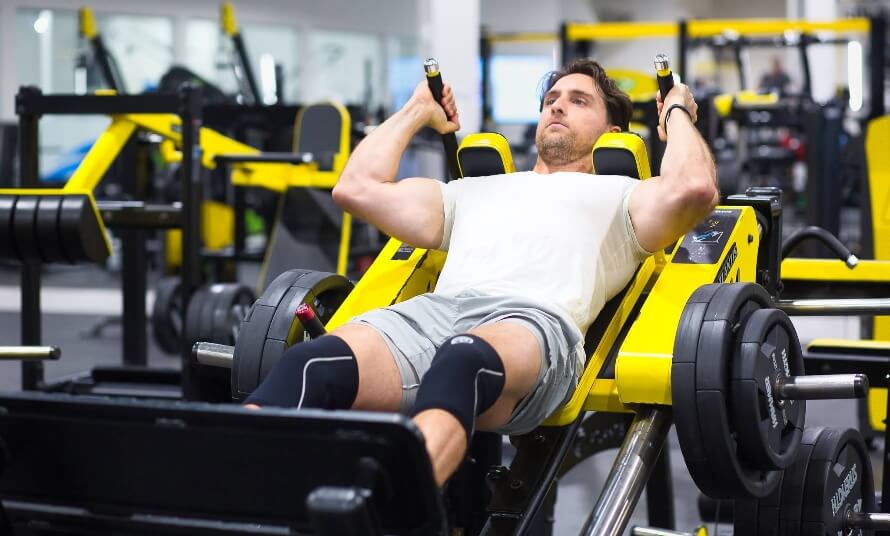
Front squats are a fantastic exercise. They train your entire lower body, all while being kinder to your spine and knees than back squats.
That said, they’re not for everyone.
Some people struggle with the wrist and shoulder mobility needed to hold the bar in the proper “rack” position. Others dislike the pressure of a heavy barbell pressing into their throat. Then there are those who find the movement’s mechanics tricky to master and end up tipping forward mid-rep.
Another drawback is that you can’t lift as much weight as you can with back squats, which doesn’t sit well with anyone chasing big squat numbers. And sometimes, people just plain don’t like front squatting.
If you fall into any of these camps, having a lineup of barbell front squat alternatives is useful.
These exercises let you reap similar benefits without forcing yourself through a movement you don’t enjoy. And that matters because when you choose exercises you like, you’re far more likely to stick with your training and make progress.
7 Barbell Front Squat Alternatives for Quad Mass & Strength
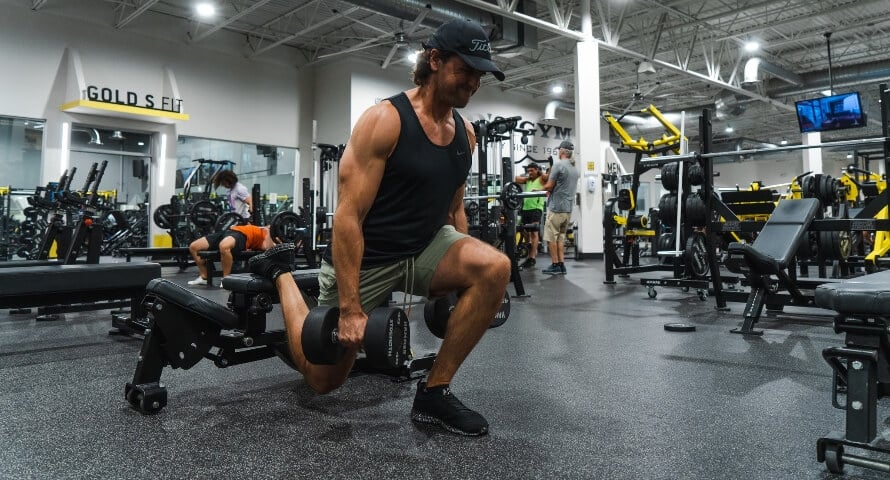

There are hundreds of front squat substitutes, but most aren’t effective enough to be a cornerstone of your training.
A worthy front squat alternative must let you lift heavy weights safely, minimize stress on your joints, allow you to implement progressive overload, and be simple to learn and execute.
The following seven exercises check all these boxes, making them the only alternatives to the front squat you need.
Incorporate them into your training and watch your quads grow.
1. Dumbbell Front Squat
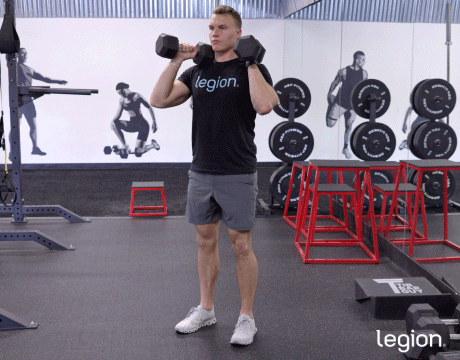

Why: The dumbbell front squat is a natural alternative to the barbell front squat because it’s essentially the same exercise, but with dumbbells. This variation solves two common complaints about the barbell version: It eliminates the pressure on your neck and requires less wrist mobility. Despite these tweaks, it still effectively trains your entire lower body, particularly your quads.
How to:
- Stand with your feet hip-width apart, holding a dumbbell in each hand with your palms facing your thighs. Take a deep breath and brace your core. Slightly bend your hips and knees as if preparing to jump.
- Drive through your heels to explode upward, using the momentum to pull the dumbbells toward your shoulders.
- As the dumbbells reach shoulder height, adjust them so the ends nearest your thumbs rest on your shoulders, then push your elbows up and out in front of you.
- Sit straight down, pushing your knees out in the same direction as your toes.
- Stand up and return to the starting position.
Expert Tip: Mastering the “clean” to get the dumbbells to shoulder height can make a huge difference in your performance because it helps you conserve energy for your working sets. Practice this during warm-ups to ensure your setup is smooth when the weights get heavy.
2. Step-up
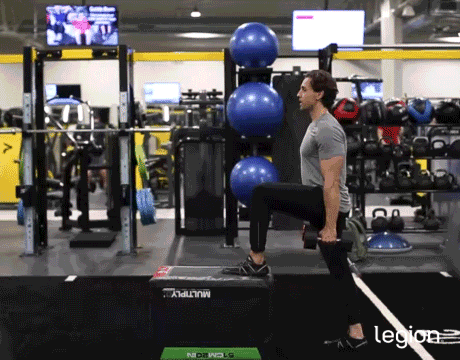

Why: The step-up is a great front squat substitute because it trains all the same muscles and is just as gentle on the joints. The reason it’s so joint-friendly is that you don’t need to lift heavy weights to make it effective.
How to:
- Holding a dumbbell in each hand, place your right foot on a stable surface about knee-height off the floor.
- Keeping your weight on your right foot, fully straighten your right leg.
- Lower your left foot toward the floor, and return to the starting position.
- Once you’ve completed the desired number of reps, switch sides.
Expert Tip: Don’t make the mistake of using a step that’s too high—it can ruin your form and make the exercise less effective. Stick to a step no higher than knee height until you’ve nailed the technique. Only go higher if you can maintain good form.
3. Safety Bar Squat
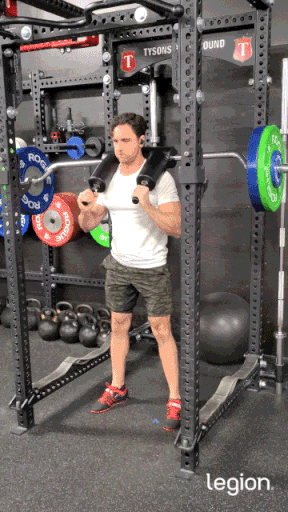

Why: The safety bar squat is an excellent front squat alternative because, although the bar rests on your back, its design shifts the weight forward to mimic the mechanics of a front squat. This allows you to reap the same benefits as front squatting without the discomfort of holding the bar in a front rack position.
How to:
- Position a safety squat bar in a squat rack at about the height of your breastbone.
- Position your head between the handles with the main bar resting on your upper back, and grab one handle in each hand.
- Unrack the bar, take 1-to-2 steps backward, and place your feet a little wider than shoulder-width apart with your toes pointing slightly outward.
- Keeping your back straight, sit down and push your knees out in the same direction as your toes.
- Stand up and return to the starting position.
Expert Tip: Keep the handles high and your elbows forward during the entire movement. Pulling the handles into your chest shifts the weight back and makes the exercise more like a low-bar squat than a front squat.
4. Bulgarian Split Squat
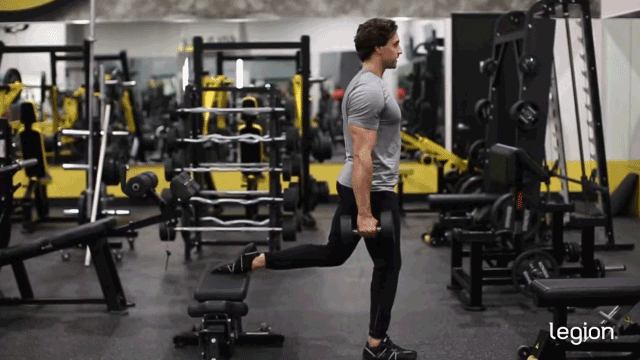

Why: The Bulgarian split squat is a top-tier barbell front squat alternative because it trains your entire lower body one leg at a time, so it’s perfect for finding and fixing muscle imbalances. It may even boost athletic performance more than barbell squats, too.
How to:
- Hold a dumbbell in each hand and stand 2-to-3 feet in front of a bench, with your back to it.
- Place your left foot on the bench behind you, keeping your right foot and heel firmly planted.
- Lower your body by bending your right knee, bringing your right thigh parallel to the floor.
- Stand back up and return to the starting position.
Expert Tip: Performing the Bulgarian split squat with your front foot as close to the bench as your mobility allows (no lifting your heel) emphasizes the quads more than when you position your foot far from the bench.
5. Hack Squat
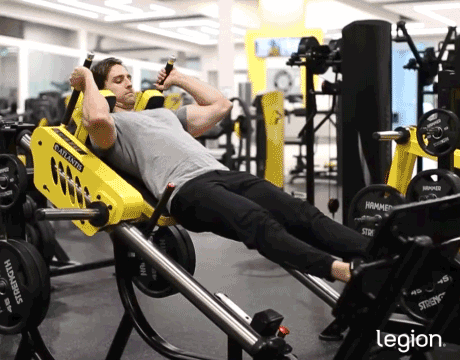

Why: In many ways, the hack squat is like a front squat machine—it trains your entire lower body through a similar range of motion and is equally kind to your joints.
How to:
- Position your body so that your feet are shoulder-width apart on the hack squat machine footplate with your toes pointing slightly outward, and your shoulders and back are against the pads.
- Straighten your knees and use the safety handles to release the weight.
- Keeping your back against the pad, sit down and push your knees out in the same direction as your toes.
- Stand up and return to the starting position.
Expert Tip: We don’t have much research specifically on the hack squat, but studies on similar machine exercises suggest placing your feet lower on the footplate emphasizes the quads. If building bigger quads is your top priority, give it a try to see how it works for you.
6. Pendulum Squat
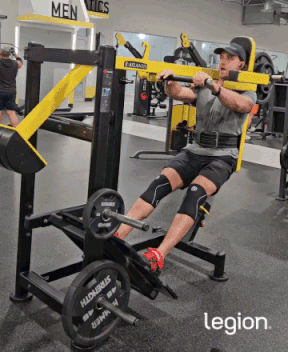

Why: Like the hack squat, the pendulum squat mimics the front squat with a machine. However, because of the way the pendulum squat machine is configured, you don’t need as much ankle mobility to perform the exercise through a full range of motion. This makes it an excellent front squat alternative for those with limited mobility.
How to:
- Position yourself in the pendulum squat machine with your back against the pad and your shoulders under the shoulder pads.
- Place your feet shoulder-width apart on the footplate with your toes pointing slightly outward.
- Straighten your knees to lift the weight and release the safety handles.
- Keeping your back against the pad, sit down and push your knees out in the same direction as your toes.
- Stand up and return to the starting position.
Expert Tip: When people try the pendulum squat machine for the first time, they usually find it surprisingly challenging compared to other free-weight and machine leg exercises. For this reason, start lighter than you’d expect and gradually build up to heavier weights.
7. Goblet Squat
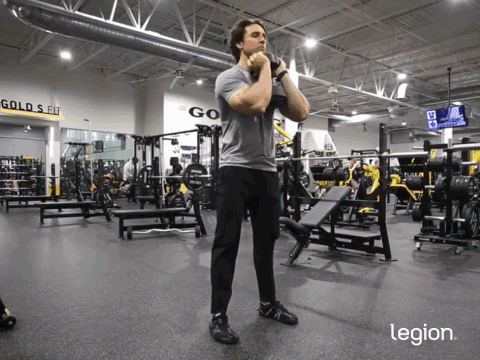

Why: The goblet squat is a solid front squat substitute for people new to weightlifting. The movement involved is very similar to the barbell front squat, but it’s easier to learn, allows you to start with lighter weights, and requires less equipment, so it’s ideal for beginners who like to train at home.
How to:
- Hold a dumbbell in front of your chest with both hands.
- Place your feet a little wider than shoulder-width apart, point your toes slightly outward, and raise your chest.
- Keeping your back straight, sit down and push your knees out in the same direction as your toes.
- Stand up and return to the starting position.
Expert Tip: Keep the weight close to your chest and bend your elbows fully. Holding the weight away from your body forces your biceps, forearms, and shoulders to bear weight, which makes balancing more challenging and limits the amount of weight you can lift.
FAQ #1: Are front squats necessary?
Front squats aren’t necessary, but they’re highly effective. They train your quads, glutes, core, and upper back while being easier on your knees and lower back than other squatting variations. That said, if you can’t or don’t want to front squat, alternatives like the safety bar squat, hack squat, or goblet squat can offer similar benefits.
FAQ #2: What’s the best front squat replacement?
The best front squat replacement depends on your goals and limitations. For instance, if you like training with a barbell but find the front rack position uncomfortable, the safety bar squat is a top choice.
For those who like training with dumbbells, the dumbbell front squat, step-up, and Bulgarian split squat are worthy barbell front squat replacements.
If you want something that’s spine-friendly and highly stable, machines like the hack squat or pendulum squat are excellent. Or, if you’re a beginner, the goblet squat is an ideal starting point.
FAQ #3: What’s the machine equivalent of the front squat?
The hack squat and pendulum squat are the closest machine equivalents to the front squat. Both replicate the front squat’s upright torso position and emphasize the quads. While they don’t engage your core and stabilizer muscles as much, they’re excellent for training your entire lower body and are easier on your back.
Scientific References +
- Simenz, Christopher J., et al. “Electromyographical Analysis of Lower Extremity Muscle Activation during Variations of the Loaded Step-up Exercise.” Journal of Strength and Conditioning Research, vol. 26, no. 12, Dec. 2012, pp. 3398–3405, https://doi.org/10.1519/jsc.0b013e3182472fad.
- Selseth, Angie, et al. “Quadriceps Concentric EMG Activity Is Greater than Eccentric EMG Activity during the Lateral Step-up Exercise.” Journal of Sport Rehabilitation, vol. 9, no. 2, May 2000, pp. 124–134, https://doi.org/10.1123/jsr.9.2.124.
- Neto, Walter Krause, et al. “Gluteus Maximus Activation during Common Strength and Hypertrophy Exercises: A Systematic Review.” Journal of Sports Science and Medicine, vol. 19, no. 1, 1 Mar. 2020, pp. 195–203, www.researchgate.net/publication/339302672_Gluteus_Maximus_Activation_during_Common_Strength_and_Hypertrophy_Exercises_A_Systematic_Review.
- Jones, Margaret T, et al. “Effects of Unilateral and Bilateral Lower-Body Heavy Resistance Exercise on Muscle Activity and Testosterone Responses.” Journal of Strength and Conditioning Research, vol. 26, no. 4, Apr. 2012, pp. 1094–1100, https://doi.org/10.1519/jsc.0b013e318248ab3b.
- DeFOREST, Bradley A., et al. “Muscle Activity in Single- vs. Double-Leg Squats.” International Journal of Exercise Science, vol. 7, no. 4, 2014, pp. 302–310, pubmed.ncbi.nlm.nih.gov/27182408/.
- Liao, Kai-Fang , et al. Effects of Unilateral vs. Bilateral Resistance Training Interventions on Measures of Strength, Jump, Linear and Change of Direction Speed: A Systematic Review and Meta-Analysis. Mar. 2022, https://doi.org/10.5114/biolsport.2022.107024.
- Deniz Erdağ, and Hasan Ulaş Yavuz. “Evaluation of Muscle Activities during Different Squat Variations Using Electromyography Signals.” ResearchGate, unknown, 2020, www.researchgate.net/publication/337400852_Evaluation_of_Muscle_Activities_During_Different_Squat_Variations_Using_Electromyography_Signals.
- Da Silva, Eduardo Marczwski, et al. “Analysis of Muscle Activation during Different Leg Press Exercises at Submaximum Effort Levels.” Journal of Strength and Conditioning Research, vol. 22, no. 4, July 2008, pp. 1059–1065, https://doi.org/10.1519/jsc.0b013e3181739445.



